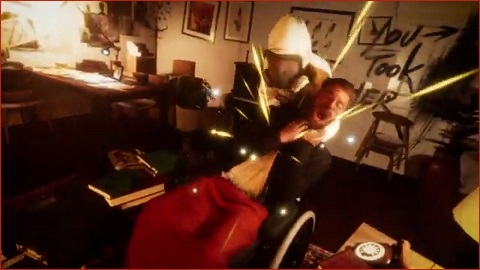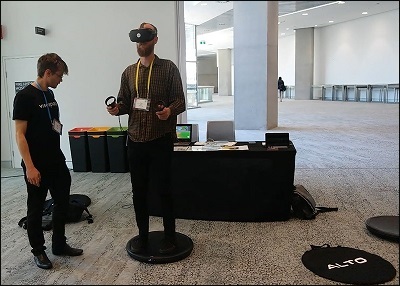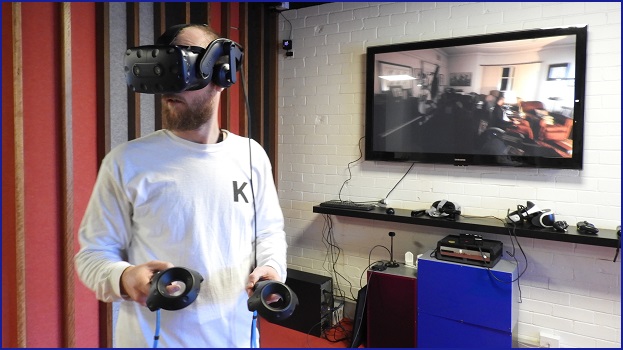On paper, virtual reality (VR) is the biggest revolution ever to happen to entertainment.
Cutting edge computer graphics, high fidelity audio, and motion tracking combine for unparalleled experiences that take you out of your living room and into a near limitless number of immersive worlds.
But what if this set of technologies offered more than a bit of immersive fun?
I got to experience first-hand the way some of Australia’s foremost VR start-ups are breaking new ground in art, technology, and what it is to be human.
A new medium for art
Hidden in a nondescript building in Sydney’s Surry Hills are the offices of StartVR.
Made in partnership with Screen Australia, the team’s VR experience ‘Awake: Episode One’ is a home-grown example of the potential VR has beyond rhythm games and first person shooters.
You watch as a man, Harry, comes to terms with his past and his very perception of reality. Harry’s wife, Rose, is dead, you glean that quickly – but did he kill her? Is Harry mentally ill? Psychotic? Or is there something bigger going on?
Over the next 20 minutes you start to piece things together. Harry has experimented with lucid dreaming, and a soundtrack of talks from Western Zen practitioner Alan Watts add to the sense of uncertain reality.
The attention to detail in the set design is impressive. Harry’s apartment feels real, lived-in, an effect aided by the lifelike figure sitting in front of you straining to understand whether or not the world he’s trapped in is real or a dream.
The likenesses of Hollywood actors Jake McDorman and Analeigh Tipton were captured using volumetric video techniques, removing the feeling of uncanny valley often so prevalent in attempted digital realism.

‘Awake’ has been nominated for the 2019 Upload VR Experience of the Year but plans for more episodes have been put on hold due to the extreme cost of the venture – recording the actors alone absorbs a lot of money and produces massive amounts of data.
What we see in this first episode is an ontological struggle that mirrors the potential VR has to transform, or even break, our own reality.
Could VR cause you to lose your grip on what's real?
Back in 2016, German philosophers Michael Madary and Thomas Metzingers explored some of the risks that widespread adoption of VR might have on society, suggesting a code of ethical conduct for both experimental and commercial uses of VR.
One concern they had was that long-term immersion in virtual worlds could have lasting effects on mental health.
“We suspect that heavy use of VR might trigger symptoms associated with Depersonalisation/Derealisation Disorder,” Madary and Metzingers said.
“Overall, the disorder can be characterised as having chronic feelings or sensations of unreality.
“In the case of depersonalisation, individuals experience an unreality of the bodily self, and in the case of derealisation, individuals experience the external world as unreal.”
They cited a 2014 experiment in which the researchers built a 1:1 replica of an office space in VR. The man in the experiment was able to work at a keyboard, walk around, rest on a lounge chair with each object in a physical space that matched exactly with the virtual objects in his headset.
The published paper from that study says that, “several times during the experiment the participant was confused about being in the [virtual environment] or in the real world, and mixed certain artifacts and events between both worlds.”
I asked the CEO and co-founder of StartVR, Kain Tietzel, if he was concerned about the potential mind-bending effects of virtual reality.
“VR tricks the brain into believing that what it is experiencing is real, and that’s part of the amazing opportunity VR brings,” he said.
“But also, as developers and as content creators we have to be responsible for their psychology, their mental health, and what they have to experience.”
Tietzel said that it becomes easier to move between virtual and real worlds over-time.
“With VR it can be a rude shock going between VR and not being VR,” he said.
“There are certainly some bad VR experiences that will make you feel nauseous or give you a headache.
“You do start to get your sea legs, so to speak – or your ‘VR legs’ – the more time you spend in VR, and there is a certain elasticity in the brain so it starts to adapt and realise there are multiple realities it’s working on.
“I think the real complex issue will come in when we have [augmented reality] headsets: glasses or contact lenses with an augmented layer of information on top.
“It’s crude at the moment, but I do see a time when we won’t be able to discern between what is real and what is not.”
Tietzel is not afraid of where this might lead. In fact, he thinks humanity will adapt to living in mixed realities – and that this tech could even improve the way we live.
“I know Kung Fu”
When ‘The Matrix’ came out in 1999, filmgoers around the world were introduced to the idea of uploading knowledge and skills into your brain at the speed of a file transfer.
VR could indeed be a step toward this near-instant training.
Australian VR start-ups like StartVR, Virtual Method, and 7DX are running with this concept and using cutting edge tech to train people in faster, more effective, and interesting ways.
7DX had a booth set up at the SingularityU conference in Sydney last week demonstrating their latest training tool.
Heading into what another very hot Australian summer, 7DX have developed a VR experience designed to teach people how to stay safe at the beach.
CEO and Founder of 7DX, Julian Ward, said his team’s rip safety experience is aimed at preventing drownings.
“The drowning epidemic in Australia is real and spends going up against it don’t seem to be working,” he said.
“We’re using VR to try and have impact on those numbers.
“A lot of rip drownings are preventable. People end up panicking and drowning themselves – often they’re not even too far from shore.
“We’re trying to teach people new behaviours around that decision-making using virtual reality.”
The rip safety experience is professional and well-made. You are quickly taught the basics of VR (how to interact with the world and move around) while ‘Bondi Rescue’s’ Bruce ‘Hoppo’ Hopkins talks you through what’s going to be involved.
First from an observation tower, then from a helicopter, you get to see simulations of different kinds of rips, with their outlines highlighted.
Then you are taken underwater to see how the current in a rip could pull you out to sea.
Finally, you are placed in neck-deep water and learn how to float by holding your arms out to your sides as the rip slowly drags you further from land.
“We use some level of exposure therapy, information, and perspective to reframe the way people think about rips,” Ward said.
“Rather than thinking ‘it’s going to take me under and out to New Zealand’, we’re trying to inform people how to stay afloat and why it’s important not to panic.”
The water simulation looks great and has an initial feeling of really being there – even though you're limited to sight and sound.
Most impressive was the sense of how the rip current drags you out to sea in a benign way that reinstated the need to remain calm.
Combine this with the multiple perspectives of what a rip looks like (something I only ever learnt through still images in primary school) and you can see how a short VR rip safety experience could make a difference.
“We believe and from our testing so-far that this will be an effective remedy and can be a one-touch experience," Ward said.
“In VR, when we override your senses and teach you things retention is very high – it might go from 15 to 90 per cent, and you get extremely high transfer from those learned behaviours.”
Being a relatively new field, academic research on VR is far from extensive. However, one meta study of research into training that uses VR found that certain skills were improved in a more effective way using VR than traditional training.
“Cognitive skills related to remembering and understanding spatial and visual information and knowledge; psychomotor skills related to head-movement, such as visual scanning or observational skills; and affective skills related to controlling your emotional response to stressful or difficult situations,” all showed signs of improvement when taught using VR.
As the VR technology improves and simulations become more realistic, the potential for learning experiences will grow.
Towards full immersion
VR is still an emerging technology and there are loads of ways to dip your feet in. You can easily get hold of a cheap piece of headgear to slot your phone in and have a – rather unsatisfying – look around virtual worlds.
On the other end of the scale is the HTC Vive that tethers to a PC to make the most of powerful hardware.
Then there’s the Oculus Quest.
Running on a mobile chipset, the Quest is a standalone device that offers all the functionality of more expensive systems with a graphical trade-off.
The Quest’s simple plug-and-play nature and ability to take it on the go (without having to lug around a $1500 PC) hint at the next generation of gaming and entertainment.
As the headsets keep improving, so do complementary technologies that look to complete the virtual experience.
The Teslasuit is a body suit that lets you feel simulated gun shots, or the heat of a virtual bushfire, and HaptX are gloves designed to closely mimic touch.
But one of the major problems VR tech still faces – regardless of its level of immersion – is movement. Virtual reality sickness is a well-documented phenomenon that presents symptoms similar to those of motion sickness.
Movement using a joystick is less intuitive than on a distanced 2D screen, and a common method of teleportation in VR (pointing at a spot in the ground and sending yourself there) is rather unsatisfying.
Sydney-based start-up Visospace has developed a round disc called the Alto that it hopes will help tackle the problem of movement.
“This is the combination of biomedical engineers solving firstly a prob in spatial computing to overcome motion sickness which occurs when your body thinks you’re going in one direction, but in VR you’re going in another direction,” Visospace CMO, Ric Holland told Information Age.

By standing on the disc and shifting your weight, you can use the Alto to move through virtual space. There are even haptics to make it feel like you are moving over different terrains. So far the devices are in the prototype stage, and working applications are limited.
“These are manufactured in Australia and have been tested on hundreds of people,” Holland said.
“There’s lots of refinement still to be done in settings and building APIs. What we’re looking for now is developers who want to put their experience into this.
“We see applications like skateboard or hoverboard games and training in emergency response situations, through to location-based entertainment games where you’re running around shooting each other.”
Its demo was a rudimentary racing game using the Oculus Quest – a good hardware choice to make sure you don’t get tangled in wires while moving.
I found this extremely challenging. Visospace’s COO, Eric Belarbre, tried his best to coach me through my run and, as the finish line neared (my time of nearly six minutes did not feature on the fastest laps scoreboard), I began to feel more confident.
One of the most interesting moments in the experience was when I came rolling up to a pendulum swinging across the course. I felt genuinely worried that it would knock me over.
Then, a bit further along, my stomach leapt up as I picked up speed rolling down hill, the haptics kicking in underfoot to heighten the sensation of movement and terrain.
I often felt like I was going to tumble off the sides of the Alto, my legs wobbling from a combination of exhilarations and uncertainty. Belarbre had to catch me on at least one occasion.
“Tall people tend to find it more difficult,” he told me.
When I finally stepped back onto the carpet, fully in control of my movement, I felt relieved.
Perhaps I don’t fully have my VR legs just yet.











